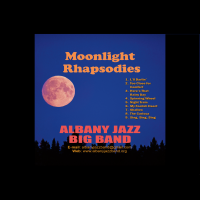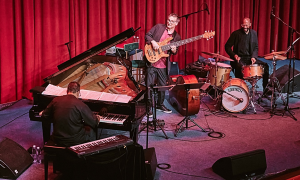Home » Jazz Articles » Profile » Ramiro Flores: Saxman in Motion
Ramiro Flores: Saxman in Motion
 "Playing standards, to me, seems a little empty. I have a lot of fun playing them, but it seems to me a little infertile. I think there are a lot of other things to do that are much more interesting," said Ramiro Flores, the 30-year-old saxophonist who has quickly become one of the most lauded players on the Buenos Aires scene—winning the 80 Mundos competition in 2006, and the newspaper Clarín's "Revelation in Jazz" prize in 2007. It's not that Flores doesn't respect history; it's that he is, by his own admission, part of a generation of Argentine musicians who are restless, thirsty, and eager to express themselves in a unique and honest way.
"Playing standards, to me, seems a little empty. I have a lot of fun playing them, but it seems to me a little infertile. I think there are a lot of other things to do that are much more interesting," said Ramiro Flores, the 30-year-old saxophonist who has quickly become one of the most lauded players on the Buenos Aires scene—winning the 80 Mundos competition in 2006, and the newspaper Clarín's "Revelation in Jazz" prize in 2007. It's not that Flores doesn't respect history; it's that he is, by his own admission, part of a generation of Argentine musicians who are restless, thirsty, and eager to express themselves in a unique and honest way. A quick listen to Flores' first album, Flores, lays out the parameters of this restlessness. The album is stylistically eclectic, rhythmically and harmonically intricate, and features bold playing. It's the work of an ambitious musician who wants to express the fullness of his identity in the course of 11 tracks.
Ramiro Flores' musical quest has followed two distinct paths. There has been the external journey on which he, as a model son of the information age, studied Stravinsky, Stevie Wonder, Coltrane, Argentine folkloric music, and tango. Then, there has been the internal journey on which he, as a model son of Buenos Aires (which is to say of two psychiatrists), used his music as a tool to dig deeper into his soul and psyche. Restlessness and enthusiasm have defined both these journeys.
When he was 21, Flores left Buenos Aires to study at Berklee College of Music in Boston, an institution that has nurtured the careers of a disproportionate number of young Argentine jazz musicians, among them Guillermo Klein, Richard Nant, Ernesto Jodos, and Ale Demogli. "First," Flores said, "I left to live alone in a foreign country, to learn to speak another language, to be alone in another world. Then, musically, there are some incredible professors there, but more than anything, to be in contact with guys my age who were tremendous musicians—I learned a ton from them."

Flores stayed at Berklee for three years, broken up in the middle by an 8-month stint playing in the show band of a Caribbean cruise ship, and then moved to New York. For two years, Flores had consistent work around the city, playing with his own group, Pedro Giraudo's big band, Los Changos, and a host of others. It wasn't hard finding gigs, Flores told me, but it proved difficult to make a living.
Economics, though, didn't drive him from New York: "I wanted to be where I'm from, in the place where I'm from," Flores said. "I didn't want to be a foreigner anymore...Maybe everything is going well with people, maybe it's not, maybe you like them, maybe you don't; but in the end, you're never going to be from there. That began to wear on me."
Flores describes his return to Buenos Aires as a sacrifice: trading his place on jazz's biggest stage for the comforts and affirmations of home after close to seven years abroad. Yet, it's in Buenos Aires where his career has flourished. When he left Buenos Aires in 1998, imitative, fusion-style playing dominated the scene. Then, with the homecomings of foreign-educated players like Guillermo Klein, the continued presence of searching, creative musicians like Quique Sinesi, and the emergence of new venues—most notably, Thelonious—the city's jazz climate began to change.
 When Flores returned to Buenos Aires in 2005, he found a group of like-minded musicians waiting for him. "First, there's traditional jazz," Flores said, describing the emerging Buenos Aires sound. "Then, you have the music from here—tango, folkloric music, all of that. But also, there's an avidity, a thirst to search for new things, a restlessness that I feel people have here. In the majority of cases, the level of technique, when you compare it to what I saw in New York, isn't the same. But there's a desire to try new things and an intellectual capacity that's very important."
When Flores returned to Buenos Aires in 2005, he found a group of like-minded musicians waiting for him. "First, there's traditional jazz," Flores said, describing the emerging Buenos Aires sound. "Then, you have the music from here—tango, folkloric music, all of that. But also, there's an avidity, a thirst to search for new things, a restlessness that I feel people have here. In the majority of cases, the level of technique, when you compare it to what I saw in New York, isn't the same. But there's a desire to try new things and an intellectual capacity that's very important." Flores doesn't shun influences—he acknowledges that "Hay" and "Barcos," the two tracks that feature singing on Flores, owe a heavy debt to Argentine folkloric music—rather it's that he loathes the idea of being imitative. "I feel, especially when I play tenor sax, that I phrase in a tango style, and it bothers me a little. When I'm playing I don't realize it, but later, when I listen to what I've recorded, I say, 'Who I am?' It seems a little tacky."
"I think where I'm interested in going is deeper into the personal," Flores told me. "At least, when I began to compose and I put out the disc, I got the feeling that I achieved—through composing, and writing, and playing music—an insight into my emotions. It's as if I was able to enter more deeply into [them] and learn more about what's happening inside of me. I'm going to continue trying to follow that path, wherever it may go."
Where it's gone so far is a lot of different directions. Flores begins with "Feraldi," a metronomic melody that gives way to the electronic distortions of the producer and multi-instrumentalist Fer Isella, before ending in a more straight-ahead trading off of solos. "Rodrigo" begins with a ticking rhythm that recalls the "Night Rider" theme song and features the pianist Hernán Jacinto dipping into the swank of the Fender Rhodes. "L'aprés-midi d'un Curupi," dedicated to the mythological Paraguayan faun, has a slinking gait that is accompanied in the final minutes by an incomprehensible vocal track that, presumably, is the curupi itself. "Zap," a sax trio number, sounds like it could have come from Joshua Redman's Back East sessions.
 Flores is keenly aware that this kind of stylistic eclecticism, this obsession with the new and the intricate, can isolate a musician in a quirky tower of his own whim. "There's a tendency towards over-intellectualization that I think can be harmful," Flores said. "[Astor] Piazzolla has things that are very complicated, but they have something inside of them. They're honest even though they're complicated. [Guillermo] Klein too. He has things that that are very complicated rhythmically, but they feel right—I'm not sure why. I'm not saying, discard intellectuality, but include it inside of yourself."
Flores is keenly aware that this kind of stylistic eclecticism, this obsession with the new and the intricate, can isolate a musician in a quirky tower of his own whim. "There's a tendency towards over-intellectualization that I think can be harmful," Flores said. "[Astor] Piazzolla has things that are very complicated, but they have something inside of them. They're honest even though they're complicated. [Guillermo] Klein too. He has things that that are very complicated rhythmically, but they feel right—I'm not sure why. I'm not saying, discard intellectuality, but include it inside of yourself." In order to satirize his own tendencies in this regard, Flores sends out an email (also posted on his website) full of postmodern garble about his upcoming shows. It's hard to see a situation where Flores would isolate himself from his audience—even when he's playing complex figures, his sense of humor and mischief shines through. For some, stylistic restlessness can be a species of discontent, an endless journey by a perpetually unsatisfied wanderer. For Flores, musical wanderings seem to be a form of play—not frivolous, but joyful. When he's up on stage, he smiles, graciously thanks the audience, and acknowledges his collaborators with affection. Rarely has anyone made plunging into the depths of the soul look like so much fun.
Selected Discography
Ramiro Flores, Flores, (BAU, 2007)
Patricio Carpossi, Vidrieras, (UANCHU, 2007)
Mariano Otero, Cu4tro, (S-Music, 2007)
Mariano Otero, Tres, (S-Music, 2006)
Esteban Sehinkman, Búfalo, (Limbo, 2006)
Pedro Giraudo, Desconsuelo, (PGM, 2005)
Photo Credits
All photos courtesy of Ramiro Flores
Tags
PREVIOUS / NEXT
Support All About Jazz
 All About Jazz has been a pillar of jazz since 1995, championing it as an art form and, more importantly, supporting the musicians who make it. Our enduring commitment has made "AAJ" one of the most culturally important websites of its kind, read by hundreds of thousands of fans, musicians and industry figures every month.
All About Jazz has been a pillar of jazz since 1995, championing it as an art form and, more importantly, supporting the musicians who make it. Our enduring commitment has made "AAJ" one of the most culturally important websites of its kind, read by hundreds of thousands of fans, musicians and industry figures every month.






























